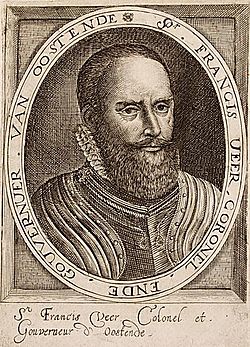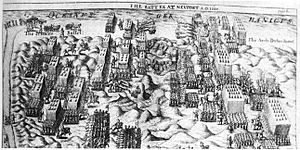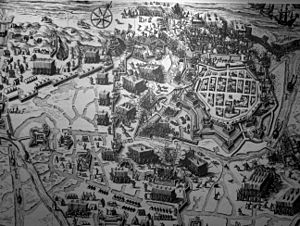Francis Vere facts for kids
Quick facts for kids
Sir Francis Vere
|
|
|---|---|

Portrait of Sir Francis Vere
|
|
| Born | c. 1560 |
| Died | 28 August 1609 (aged 48-49) |
| Buried | Westminster Abbey |
| Noble family | De Vere |
| Spouse(s) | Elizabeth Dent |
| Father | Geoffrey Vere |
| Mother | Elizabeth Hardekyn |
Sir Francis Vere (born around 1560 – died 28 August 1609) was a famous English soldier. He worked for Queen Elizabeth I and fought mostly in the Netherlands. He took part in two big wars: the Anglo-Spanish War and the Eighty Years' War.
In 1589, he became a top general for English and Scottish soldiers. He kept this job for 15 campaigns, almost always winning against the Spanish. His most famous win was at the Battle of Nieuwpoort. He worked very well with the Dutch leader, Maurice of Nassau, helping the Netherlands gain its independence.
Contents
Who Was Sir Francis Vere?
His Family and Early Life
Francis Vere was born around 1560. He was the second son of Geoffrey Vere from Essex, England. His mother was Elizabeth Hardekyn. Francis had three brothers, including Sir Horatio Vere, who also became a famous soldier. He also had a sister named Frances.
Francis Vere was elected to the English Parliament in 1593. This meant he helped make laws for the country.
His Marriage
Francis Vere often visited his friend, Sir Julius Caesar, in Surrey. Sir Julius had a stepdaughter named Elizabeth Dent. Francis and Elizabeth fell in love. They got married on October 26, 1607. Elizabeth was 16 and Francis was 47. They were married for about two years before he died, and they did not have any children.
Sir Francis Vere's Military Adventures
Starting His Military Career
Francis Vere began his military service in 1585. He joined the army under Lord Leicester in the Netherlands. This area was a major battlefield at the time. He quickly showed his bravery and skill.
During the siege of Sluys, he fought bravely. In 1588, when the Spanish Armada threatened England, Vere was sent to Vlissingen to stop a Spanish landing. He also helped destroy a Spanish ship called the San Mateo near Ostend. Later, he helped the English soldiers defend Bergen op Zoom from a Spanish attack. Because of his heroic actions, he was made a knight on the battlefield.
The Ten Years' Campaign (1588-1598)
After these early successes, Sir Francis Vere became the main commander of English and Scottish troops in the Netherlands. He worked closely with Maurice of Nassau, the Dutch leader. This period was known as the Ten Years' Campaign.
Vere helped take back several important cities from the Spanish. These included Breda, Zutphen, and Deventer. He even ordered that a traitor, Rowland York, be dug up and displayed as a warning. These wins helped make up for earlier losses caused by English traitors.
Vere continued to earn respect for his actions. He helped defeat the Spanish at the Siege of Knodsenburg in 1591. Nearly half of the army were English and Scottish soldiers under Vere's command. After this, Maurice and Vere captured Hulst.
In 1592, Vere led a brave attack during the Siege of Steenwijk. Even though he and his brother Horace were wounded, the attack succeeded. The Spanish then surrendered the town. The Anglo-Dutch army also captured Coevorden. By 1594, they had also captured Groningen. These victories pushed the Spanish out of the northern parts of the Netherlands. This helped the country gain its independence.
Vere became known as one of England's best soldiers. His troops were well-trained and could face the best Spanish armies. Many young English soldiers came to learn from him, including his younger brother Horace. Even the famous writer Ben Jonson served under him.
Expedition to Cádiz and Turnhout
In 1596, Vere joined an expedition to Cádiz in Spain. He was made a top general for the army. On June 30, Vere's experienced soldiers led the attack on the city and captured it. The English and Dutch held Cádiz for two weeks. Vere received money from wealthy prisoners. The town was then set on fire, and the fleet left. Vere shared in the valuable goods taken and was celebrated when he returned to England.
The next year, in 1597, he was back in the Netherlands. He played a key role in the Battle of Turnhout. This was a rare open battle against the Spanish army. The English and Dutch cavalry defeated the Spanish cavalry, then attacked the Spanish foot soldiers. Vere received a special note from Queen Elizabeth congratulating him. He was even featured in plays in London! The next year, he helped negotiate a new agreement for the Anglo-Dutch alliance. He also became the governor of Brielle.
Battles at Zaltbommel, Nieuwpoort, and Ostend
In 1599, the Spanish attacked the area around Zaltbommel. They tried to surround the town. But Vere crossed the river with 6,000 men and successfully attacked a Spanish position. The Spanish army was in trouble and had to retreat. Their army fell into chaos, and they stopped fighting for a few years.
The most important moment in Vere's career came in 1600. The Dutch decided to take the war into Spanish territory. At the Battle of Nieuwpoort (July 2, 1600), Maurice of Nassau, with Vere's help, defeated the experienced Spanish army. This was one of the toughest battles of that time.
After Nieuwpoort, Vere took command of the soldiers defending Ostend starting in July 1601. The Spanish, led by Archduke Albert, surrounded the town. Vere was badly wounded in the head during a Spanish attack in August but returned to duty a month later. In December, a Spanish attack on the outer defenses was defeated. Many of the attackers were killed, wounded, or captured.
As the siege continued, it became hard to get more soldiers into Ostend. Vere learned that the Spanish were planning a huge attack. He used a clever trick to delay them. He pretended to want to talk about peace. This gave his engineers time to repair the town's defenses.
When the Spanish attack finally came on January 7, 1602, the defenders were ready. About 10,000 Spanish soldiers attacked Ostend's main walls in the dark. Vere directed his soldiers, making sure the defenses were strong. The Spanish attacked but were pushed back everywhere. They did manage to capture one spot, but Vere ordered it to be taken back. An English company drove the Spanish out. Vere then opened a special gate that let water rush through, sweeping many Spanish soldiers into the sea. The Spanish lost between 1,500 and 2,000 men in this failed attack.
Vere stayed in Ostend for a few more months. He was then called away to lead troops in other battles. He returned to England in March 1602 and was praised for his success in defending Ostend. English troops continued to fight with the Dutch until Ostend finally surrendered in September 1604.
Final Campaigns and Retirement
Vere went back to the Netherlands in 1602 with more troops. He and Maurice surrounded the Spanish soldiers at Grave. Vere was injured under his right eye during this siege. He recovered and continued to serve with the Dutch army through 1603-1604. He also remained the governor of Brill.
When King James I made peace with Spain in 1604, Vere retired from the army. He spent the rest of his life in England. He wrote about his military experiences in a book called Commentaries of the Divers Pieces of Service. This book was published after his death.
Death and Burial
Sir Francis Vere died on August 28, 1609. This was soon after a peace agreement called the Twelve Years' Truce was signed. This agreement officially recognized the independence of the Netherlands. Vere was buried in Westminster Abbey in London.
His tomb is a large monument made of alabaster and black marble. It shows him lying down in civilian clothes, with his armor laid out on a slab above him. This slab is held up by four life-sized knights kneeling at each corner. His tomb is a famous sight in Westminster Abbey.






